| Report to Congress: October 1, 2000 |
Charlotte Region
Susan B. Hardy serves as Director of the Charlotte Regional Census Center.
Following are the states located in the Charlotte Region and the Local Census Offices in
those states reviewed by the Census Monitoring Board:
Kentucky: Corbin LCO
North Carolina: Monroe LCO
South Carolina: Conway LCO
Tennessee: Nashville LCO (CMBC only)
Virginia: Richmond LCO
Highlights of the Region include:
- Approximately 12,620,529 Housing Units
- 208,744 Square Miles
- 5 States, 496 Counties
- 4 American Indian Reservations
- 2,278 Governmental Units
- 44 Members of the U.S. House of Representatives
- 10 U.S. Senators
- 50 Local Census Offices
Additional items of interest include:
- Second largest number of housing units among all regions
- Highest representation in the U.S House of Representatives
- Largest address listing workload for Census 2000
- More than a 50 percent increase in the number of Hispanics between 1990 and 2000 in NC, SC and TN
- More than a 60 percent increase in the number of Asian Pacific Islanders in all 5 states
- The percentage of the African American population is larger in NC, SC, TN and VA than the 1998 national average
- NC ranks seventh in total American Indian / Alaska Native population (1990 census)
- The percentage of high school graduates is smaller in KY, NC, SC and TN than the national average
- The unemployment rate is lower than the national average in NC, SC, TN and VA
CORBIN
Local Census Office #2811
Overview
Dates of Visits:
April 7, 2000
May 18, 2000
June 20, 2000
Mailback Response Rate
56%
NRFU Workload
108,319 housing units
LCO Type
Type C Office (includes mailout/mailback and update/leave enumeration areas)
Geographic Description
The Corbin LCO was located at 103 23rd Street, Corbin, Kentucky. According to the
February 2000 Tract Action Plan, there were 144 tracts, of which 66 (45.83 percent) were HTE.
According to the 1990 PDB, there were 210,607 housing units. The LCO was responsible for 24 counties
in southeastern Kentucky, between the remains of the coal mining industry to the north and east
and the tobacco farms to the west. The population, less than 1.5 percent of whom are members
of minority communities, is largely rural and about
80 percent of its households were served by the
U/L process.
Pay Rates

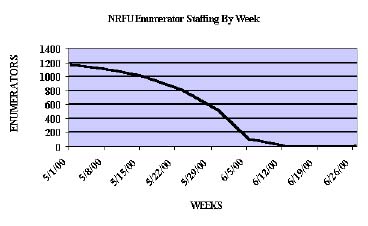
CORBIN
Local Census Office # 2811
Presidential Members' Summary
Summary
The Corbin office was able to stay on track with its duties and completed its NRFU
operations ahead of schedule. The Kentucky LCO, bolstered by competent management and relatively
few personnel problems, completed NRFU on June 7, 2000—one week earlier than anticipated.
Observations
At the time of our first visit in May, the LCO surpassed its national recruiting goal with an
applicant pool of 8,000. The Corbin office attributed its recruiting success to heavy reliance on
telephone cold calling and "word-of-mouth" advertising.
While recruiting numbers were high, obtaining and retaining qualified staff remained challenging.
Given the type of work required, wages were viewed as low by the LCOM. However, the
turnover rate stayed within national expectations at 50 percent. The turnover rate can be misleading
because a large proportion of the applicant pool never attended introductory training or started in the field.
During our first visit, it was reported that the NRFU workload was approximately 110,000
housing units — greater than the expected 92,000. In order to combat this escalation, additional
staff, including an extra FOS, was hired. The LCO hired just under 1,000 employees to conduct
field operations.
NRFU operations in Corbin were reportedly difficult due to the rural and sparsely populated
nature of the state. For example, houses can be more than 4-5 miles apart, thus limiting the number
of houses an enumerator can reach per hour. Despite this challenge, the office was able to
remain ahead of the national operations schedule.
The Corbin LCO covered 24 counties. Most of the counties created CCCs and the
relationship between the LCOs and CCCs were good. County judges used their influence to play an
instrumental role in promoting the census. Public access TV provided a local perspective to the
national advertising campaign.
CORBIN
Local Census Office #2811
Congressional Members' Summary
Summary
Three factors made hiring difficult for the Corbin LCO: landscape, demographics and low
unemployment rate. However, positive working relationship with the CCCs and assistance from
local elected offices help to overcome these difficulties.
Observations
Poverty, geographic isolation, and irregular housing characterize the HTE tracts. Throughout
the LCO's region, residents of the Appalachian community and a Spanish-speaking migrant
community were reluctant to give information because of privacy concerns and general mistrust of
government. These attitudes, combined with sparsely populated, mountainous terrain contributed to
the difficulties for enumeration of this area. However, effective partnerships between the Bureau
and local governments, supported by elected federal officials, solidified recruiting and planning efforts.
Unlike other offices, the Corbin LCO was not required to utilize the entire "Toolkit" to their
HTE plan, but the LCO staff reported those that were used were effective. However, the LCOM and
the office's Partnership Specialist expressed concern with their ability to enumerate the
migrant workforce.
The office's recruiting efforts were successful in nearly meeting its overall hiring goal. The
LCO staff reported recruiting difficulty in Laurel County where applicants described wages as
noncompetitive. Due to the county's strong economy, expanding employer base, and 3.6 percent
unemployment rate, the LCO struggled to find job applicants.
The LCO staff reported Reinterview was successful in maintaining quality control. Special
Places Enumeration was conducted in late March at a federal prison, five colleges and campgrounds
and marinas. NRFU was completed on June 9. Of all the enumerators hired, only six had
submitted incomplete or false data. After the employees were terminated, work was reassigned and redone
by other enumerators.
The Corbin LCO staff and its associated Partnership Specialist established good working
relationships with county CCCs, especially in Bell, Pulaski and Taylor Counties. The chairmen of
the CCCs were instrumental in obtaining cooperation from local media for in-kind contributions.
These efforts included donations of airtime on radio and ad space in newspapers for census awareness
and enumerator recruitment. In addition, the CCCs were helpful in suggesting sites for 17 QACs
and 20 other "Be Counted!" sites.
The LCO management staff reported that U.S. Representative Hal Rogers
(R-5th) was particularly helpful to their efforts. In addition to attending the office's grand opening, Representative
Rogers appeared in PSAs urging constituents to fill out their forms and send them in or complete a
"Be Counted!" form. The LCO staff reported maintaining regular contact with Representative Rogers'
district office. Results from the Corbin office demonstrate how valuable the work of elected
officials, such as Members of Congress, is to the census.
MONROE
Local Census Office #2823
Overview
Dates of Visits:
March 30, 2000
May 5, 2000
June 8, 2000
Mailback Response Rate
59%
NRFU Workload
115,380 housing units
LCO Type
Type C Office (includes mailout/mailback and update/leave enumeration areas)
Geographic Description
The Monroe LCO was located at 106 Sunset Drive, Monroe, North Carolina. According to
the February 2000 Tract Action Plan, there were 111 tracts, of which 84 (75.68 percent) were
HTE. According to the 1990 PDB, there were 216,396 housing units. The LCO was responsible for
seven counties: Anson, Cumberland, Hoke, Richmond, Robeson, Scotland and Union. The population
in several of these counties is largely rural and served by the U/L process. The MO/MB
process serves several bedroom communities outside of Charlotte and Fayetteville as well as several
low-income and minority communities.
Pay Rates

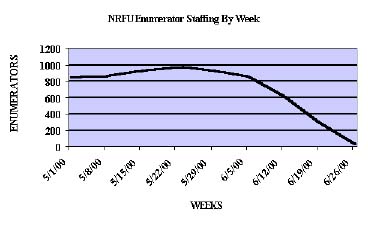
MONROE
Local Census Office # 2823
Presidential Members' Summary
Summary
The Monroe LCO was responsible for operations in seven predominately rural and racially
diverse counties: Cumberland, Union, Richmond, Anson, Robeson, Hoke and Scotland. The office
was able to overcome its lower than expected response rate with sound management to complete
NRFU operations ahead of the national deadline.
Observations
The office was blessed with stable management. At the time of the first visit, the LCOM had
been in charge for more than year and demonstrated a strong command of administrative issues
and operational requirements.
Monroe, like many other offices, faced staffing challenges. Recruiting was especially arduous
in Union and Cumberland Counties, where unemployment hovered at approximately 2 percent.
The LCO had difficulty finding qualified full-time employees. Consequently, the office relied
heavily on part-time staff and hired more enumerators than originally forecasted. In an effort to boost
applications, the LCOM proposed placing advertisements in local newspapers. This plan was
promptly approved by the Charlotte Regional Office. The additional advertising effort was further
augmented by a 75 cent per hour wage increase for staff and RCC-approved overtime.
NRFU operations began on May 1 and finished ahead of the national deadline in mid-June.
As expected, the office encountered the greatest respondent resistance to long-form interviews.
The office used its best enumerators to work on the harder cases and to follow-up with initial refusals.
Often times a crew leader or FOS accompanied enumerators on post-initial refusal visits.
Despite the best efforts of the field staff, management reported that many respondents were willing to
give only their name and/or other basic information. Additionally, the comments of certain
national political and media figures were thought to have had a negative impact on public cooperation
with the Census. In some instances, respondents even quoted the words of such personalities to
enumerators when pressed for more complete information.
Monroe succeeded in establishing 75 QACs within the LCO's jurisdiction and enlisted the
assistance of some 170 volunteers to staff them. The office is to be commended for locating
willing volunteers. Most LCOs around the country were unable to locate sufficient numbers of
volunteers and employed paid clerks to staff the QACs. A contributing factor to the lower than
expected turnout at the QACs was that respondents had to bring their own questionnaires.
Management suggested a central QAC toll free telephone number—that people could call to learn the
location and hours of the nearest center—for the 2010 census.
MONROE
Local Census Office #2823
Congressional Members' Summary
Summary
The Monroe LCO faced several challenges, including a high number of HTE tracts and a
linguistically isolated Hispanic community. The Partnership Specialists assisted in outreach, particularly
to churches and the use of QACs appeared to be successful in reaching Spanish-speaking residents.
Observations
Among the office's seven-county area, three-quarters of its tracts were classified as HTE.
The Bureau faced a variety of challenges in each county. For instance, several Hispanic migrant
communities were present in Cumberland and Union Counties; Native American communities
(Lumbee and some Tuscarora) in Robeson County; and the Fort Bragg military community near Fayetteville.
In Anson County, and to a lesser extent, some areas in Hoke County, the Bureau faced
poverty, high illiteracy rates and poor 1990 mailback response rates. Mobile home parks in all seven
counties and gated communities in Cumberland county challenged enumerators. The LCO
management staff wrote an HTE Action Plan to address its difficult tracts, although the LCOM discussed
only the blitz enumeration strategy that was employed in public housing developments during the
weekend of April 29 - 30.
The office's recruiting efforts met with mixed success. According to the April 21 final
national recruiting report, the office had tested only 88 percent of its goal and 83 percent were
considered qualified applicants. However, during interviews, the LCO staff reported little overall
difficulty, especially in Anson County, where people sought employment due to plant and mill closings.
The LCO staff described wages as competitive.
QACs were especially successful in distributing Spanish forms to the Hispanic community. In
fact, they were so successful that 4,000 additional forms had to be ordered.
Partnership Specialists, one of which was Native American assisted with the Monroe office's
outreach and awareness endeavors. Many efforts were directed to African-American community
leaders, including pastors. Several ministers, like the pastor of Elizabeth Missionary Baptist,
established testing sites at their churches and regularly promoted the census at their services. The
LCOM reported during the March 30 visit that one of the best community introductions the Bureau
had received was the endorsement by local pastors of Census 2000.
The Monroe LCOM established working relationships with at least five local county CCCs
and described the Cumberland County organization as very active and well organized. The LCOM
also worked with a women's shelter to ensure that its residents were counted.
CONWAY
Local Census Office #2860
Overview
Dates of Visit:
April 13, 2000
May 25, 2000
July 7, 2000
Mailback Response Rate
47%
NRFU Workload
92,385 housing units
LCO Type
Type C Office (includes mailout/mailback and update/leave enumeration areas)
Geographic Description
The Conway LCO was located at 1515 Fourth Avenue, Conway, South Carolina. According to
the February 2000 Tract Action Plan, there were 65 tracts, of which 23 (35.38 percent) were HTE.
According to the 1990 PDB, there were 137,136 housing units. The LCO is responsible for
four counties (Georgetown, Horry, Marion and Williamsburg). The U/L process serves about 60
percent of the population, with the remaining 40 percent by the MO/MB process. About 50 percent
of the population is white, 25 percent Africa-American and five percent Hispanic.
Pay Rates

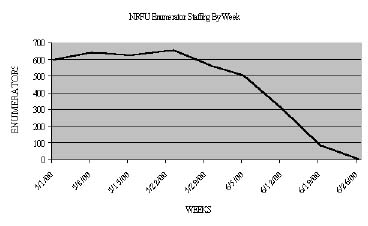
CONWAY
Local Census Office #2860
Presidential Members' Summary
Summary
Management changes at the Conway LCO significantly improved operations, allowing the office
to complete NRFU ahead of schedule.
Observations
This office was responsible for operations in four counties in the Northwest corner of the
state: Horry, Marion, Williamsburg, and Georgetown. It employed two methods
(mail-out/mail-back and update/leave) to enumerate its 65 tracts, 23 of which were categorized as HTE.
The tourism-oriented economy, vast new construction, and the high number of vacation homes
and partial year residents combined to pose unique challenges to Census operations in this section
of South Carolina.
NRFU operations were completed ahead of schedule despite a lower than expected mail back rate.
Further complicating matters, management reported that the comments of certain national
media and political personalities had a general detrimental effect upon public cooperation with
Census operations.
Competition from the robust tourist-oriented economy was cited as the principal reason the
office reached only 90 percent of its recruiting goal. To combat Conway's difficulty recruiting and
retaining sufficient numbers of qualified rank-and-file employees, Horry County workers received
a raise of $1.75 per hour. This pay rate increase appeared to ameliorate some of the staffing strain.
Furthermore, Conway was initially led by a relatively inexperienced management team. Three
different LCOMs ran the office within a six-month period. The third LCOM was the original
partnership specialist. Operational efficiency improved under her leadership.
Though contact with area political leaders was irregular, overall the office's outreach efforts
proved successful. The majority of local governments participated in LUCA and expressed
satisfaction with the process. The partnership specialist assigned to the office established particularly
strong relationships with the African-American community. Several area African-American
churches provided QAC space and actively encouraged their congregations to participate in the census.
CONWAY
Local Census Office #2860
Congressional Members' Summary
Summary
The Conway LCO was challenged by turnover among the assistant managers. The LCO also
faced difficulties recruiting due to its location in a popular tourist region and the changing housing
market. The LCO, however, was strongly supported by local elected officials and CCCs.
Observations
Within the office's four-county area, including the famous Myrtle Beach resort area, about
two dozen tracts were classified as HTE. The Bureau faced a variety of challenges in each county,
but the one cited most often was pockets of illiteracy scattered throughout. According to one
LCO manager, this may have affected the overall final response rate (approximately 45 percent,
but comparable to 1990's return rate), as well as the completeness of census long forms.
During our April 13 visit, the LCO management staff reported a 10 percent margin of error in
maps supplied following LUCA, due in large part to houses destroyed by recent hurricanes and storms.
During our May 25 meeting, the LCOM reported 10,000 UAAs, the majority of which were
condominiums in North Myrtle Beach, had been hand-delivered, following a directive by the
Charlotte RCC.
The Conway LCO's largest challenge was in recruiting. According to the April 20 final
nation recruiting report, the office ranked
39 of the Charlotte RCC's 50 offices, having tested only
69 percent of its goal and obtaining only 58 percent of its qualified applicant goal. The LCO
management attributed this difficulty to the area's large tourism industry. While it was felt that
hourly wages were comparable, many other employers offered year-round employment with the
possibility of tips. Like other employers near Myrtle Beach, the Bureau did not reach its hiring goals
in Horry County. Private-sector employers regularly bus their employees into work from other
counties. The Bureau countered with a May 28 hourly pay raise for enumerators from $8.75 to $10.50.
There were also substantial changes in management staff throughout the course of our visits to
the Conway LCO. During our April 13 visit, the LCOM reported 100 percent turnover among his
four assistant managers, and he was new as well. By the May 25 visit, the LCOM had been
replaced again.
The Conway LCO staff and its associated Partnership Specialist noted the support that U.S.
Representative Mark Sanford (R-1st) provided to the census. Monthly meetings with congressional
district offices helped maintain good working relationships. Four local county CCCs and
municipal CCCs in Horry County assisted in awareness and promotion of the census.
Volunteers manned most of the office's 36 QACs (including at least one per HTE tract), that
recorded 139 visits by residents. While there were QACs established in city halls and in the rural communities at firehouses, many of the successful QACs were located at area churches. The
LCO staff noted St. James Cathedral, a Roman Catholic parish serving the rapidly growing
Hispanic community for its successful outreach.
NASHVILLE
Local Census Office #2842
Overview
Dates of Visits:
March 29, 2000
May 8, 2000
June 15, 2000
Mailback Response Rate
64%
NRFU Workload
93,011 housing units
LCO Type
Type C Office (include mailout/mailback and update/leave enumeration areas)
Geographic Description
The Nashville LCO was located in the U.S. Customs House at 701 Broadway, Nashville,
Tennessee. According to the February 2000 Tract Action Plan, there were 109 tracts, of which 31
(28.44 percent) were HTE. According to the 1990 PDB, there were 229,064 housing units. The LCO,
one of ten in the state, is responsible for the city of Nashville and Davidson County. The HTE areas
that the LCO staff has concentrated on include the neighborhoods with Kurdish, Laotian and
Hispanic populations.
Pay Rates

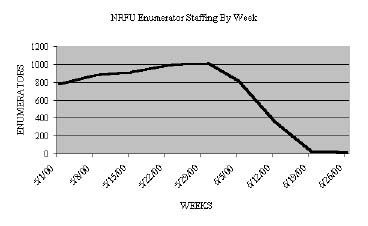
NASHVILLE
Local Census Office #2842
Presidential Members' Summary
[The Presidential Members of the Monitoring Board did not visit the Nashville LCO.]
NASHVILLE
Local Census Office #2842
Congressional Members' Summary
Summary
The Nashville office demonstrated how strong recruiting efforts, effective partnerships and
support from elected officials can significantly improve mail response rates and strengthen follow-up
planning efforts.
Observations
The city of Nashville had impressive results during Census 2000. The mailback response rate
for the Nashville office was 65 percent, an improvement of nine percentage points over the 1990 rate.
This LCO was ranked second nationally in this category (response rate increase since the last
decennial census).
The Nashville CCC and the city of Nashville established good working relationships with the
Bureau, although the local CCC was not formed until after September 1999. Members of the
CCC, including community organizations such as the Nashville Public Housing Authority were
instrumental in establishing QACs throughout the city, one in each HTE tract. QACs, Be Counted
sites and training facilities were often provided gratis by members of the CCC. Other partners, too,
were notable for their support of Census 2000. For example, Kroger grocery stores provided coffee
and pastries to both the homeless and the enumerators during Special Places efforts, while the
Nashville police department provided plain-clothes escorts during Blitz Enumeration. Management staff
of the Nashville LCO reported U.S. Senators Fred Thompson (R) and Bill Frist (R) were
particularly helpful to their efforts. In addition to general support, promoting awareness, both elected
officials included recruiting and hiring information in constituent newsletters. Results from the
Nashville office demonstrate the value of effective partners, supported by elected federal legislators, in
ensuring a successful census.
Within the office's HTE tracts, the Bureau faced pockets of linguistic isolation in the
Kurdish, Laotian and Hispanic neighborhoods as well as the traditional challenges of enumerating
public housing projects. Though LCO management staff wrote an HTE Action Plan in August 1999
to address its HTE tracts, neither LCO staff nor the Charlotte RCC provided a copy to the
Monitoring Board for evaluation. The plan was written in cooperation with church leaders, especially those
in the minority communities; the president of Union Planters Bank; area CEOs and Nashville
mayor Bill Purcell.
The office's recruiting efforts were successful in gaining an effective cross-section of
enumerators throughout the office's area, especially in the HTE tracts. To recruit in the Kurdish
community (estimated at 4,800 to 8,000 and reported to be the largest in the country), the office
established partnerships with Catholic Charities. However, a local Hispanic leader suggested a more
concerted effort needed to be made in the Spanish-language media in order to reach the estimated
30,000 members of this community and to overcome fear of the census and distrust of the government.
We are concerned with the 13,079 forms returned to the LCO as UAA reported during the May
8 visit, though all but 831 were redelivered by enumerators.
RICHMOND
Local Census Office #2852
Overview
Dates of Visits:
March 30, 2000
May 2, 2000
June 12, 2000
Mailback Response Rate
58%
NRFU Workload
40,454 housing units
LCO Types
Type A Office (entirely mailout/mailback, mainly urban, hardest to enumerate)
Geographic Description
The Richmond LCO was located in The Exchange Place, at 1313 East Main Street,
Richmond, Virginia. According to the February 2000 Tract Action Plan, there were 71 tracts, of which
55 (77.46 percent) were HTE. According to the 1990 PDB, there were 94,141 housing units.
The LCO was responsible for the city of Richmond.
Pay Rates

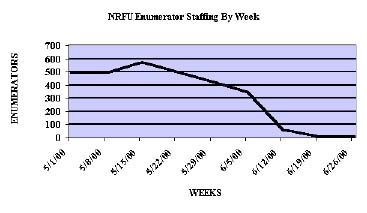
RICHMOND
Local Census Office #2852
Presidential Members' Summary
Summary
The LCO's geographic jurisdiction coincided with the city limits of Richmond. The initial
mail response rate for the LCO was dramatically higher than expected at 58 percent. This reduced
the expected workload by at least 10,000 housing units. With a reduced workload, the LCO was able
to finish NRFU operations ahead of the national deadline by June 14.
Observations
Overall, the management team at the Richmond LCO appeared knowledgeable, highly
motivated and were familiar with all the operational issues raised. Recruiting and training was on
schedule and the field management structure they described conformed to the Bureau's standards for
workload levels and crew leader/enumerator ratios.
The HTE tracts for 2000 correlated closely with the low response rate tracts of 1990. The
LCO manager reported that these HTE tracts were dominated by large, multi-unit housing structures.
Out of 71 tracts for which the LCO was responsible, 55 were HTE.
This LCO had just over 40,000 housing units to enumerate during NRFU. The LCOM said
that cooperation with census employees was enhanced because of national and local media
advertising and stories. On the other hand, enumerators in Richmond also experienced a high number of
respondents answering the door armed.
This LCO initially reported some trouble recruiting applicants from hard-to-enumerate areas.
However, increased recruitment advertising in community newspapers, a targeted postcard mailing,
and assistance from the Virginia Employment Commission boosted these efforts.
The LCOM criticized the pay scale for LCO managers and senior staff. He felt there was
not enough of a differential between enumerators and management, and that this was causing
some management retention problems. All the senior managers in the LCO were retired
federal/military employees. Without access to those employees, the LCOM said it would have been impossible
to hire and retain a sufficient number of qualified people.
All enumerators interviewed or accompanied on visits were well-trained and handled each
situation with professionalism. The Richmond office used a common LCO technique by selecting
particularly skilled enumerators to obtain data from difficult non-respondents. They were called the
"Silver Tongued" enumerators.
The LCOM identified the Richmond Mayor and City Manager as extremely helpful to the
LCO's efforts, particularly in publicizing the census. The Richmond CCC hosted a dinner for the
homeless to help with the homeless count.
RICHMOND
Local Census Office #2852
Congressional Members' Summary
Summary
The Richmond LCO faced difficulties recruiting and enumerating the HTE neighborhoods, as
well as the challenge of outreach activities without the help of a Partnership Specialist. Fortunately,
the LCO maintained good working relationships with city officials, who promoted awareness and
corporate sponsors, that helped establish at least one QAC in every census tract.
Observations
Almost three-quarters of the office's tracts were HTE, and to address them, the LCO
managerial staff wrote an HTE plan to assist employees in enumerating these areas. These tracts are
predominantly in low-income African-American communities or in areas with high-crime rates. The
primary strategy from the Bureau's "Toolkit" was team enumeration, aided by blitz enumeration
in the worst HTE neighborhoods. The office faced some reluctance in certain sections of
public housing, even during its blitz enumeration.
While the office was reportedly slower than others in meeting its recruiting goals, the staff
explained that it had to recruit throughout half the state as an Early-Opening Local Census
Office, delaying its own efforts in a hard-to-recruit urban area. The office's most notable recruiting
story was an employee's successful welfare-to-work transition. The office's AMR noted a female
employee, hired originally as a clerk, received several promotions during Census 2000. Her
transportation costs were paid by a social service agency.
The Bureau maintained good working relationships with local elected officials and municipal
officials, especially in the city of Richmond. The arrangement between the Bureau and the
city's census liaison was key in verifying HTE and Special Places locations. Richmond Mayor
Timothy M. Kaine made PSAs, spoke at a City Council hearing and appeared on television to promote
the census and raise awareness.
The office exhibited very good cooperation among managerial staff. Without a Partnership
Specialist, the LCOM and his managers made many of the typical partnership outreach activities.
During the June 12 visit, the LCOM noted the largest spikes in response and cooperation coincided with
his local television appearances. Corporate partners were vital to the census' success as well. The
7-11 convenience store chain helped establish a QAC in every one of its Richmond stores. The
LCOM reported this cooperation permitted the Bureau to establish one QAC in every census tract, and
in some tracts, more than one.





